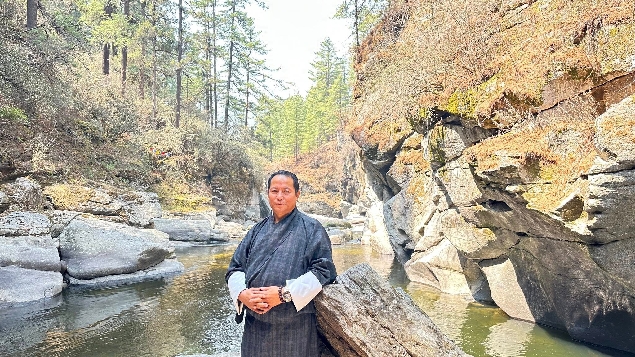Cradled in the quiet heart of Tang Valley, Bumthang, lies a site of extraordinary spiritual legacy—Mebar Tsho, the Burning Lake. Far more than a tranquil pool along the Tang River, this revered place is etched into the soul of Bhutanese Buddhism. It marks the sacred beginning of Terton Pema Lingpa’s (གཏེར་སྟོན་པདྨ་གླིང་པ 1450-1521) divine mission as a treasure revealer, and continues to inspire devotion, wonder, and pilgrimage to this day.
𝗔 𝗦𝗮𝗰𝗿𝗲𝗱 𝗝𝗼𝘂𝗿𝗻𝗲𝘆 𝗙𝘂𝗹𝗳𝗶𝗹𝗹𝗲d
Visiting Mebar Tsho had long been a personal aspiration. When the opportunity finally came, I arrived to find the footpath temporarily closed for maintenance. Yet something deeper than circumstance called me onward—a quiet pull of devotion. Mindful not to disrupt the work underway, I made my way carefully to the site. There, surrounded by the gentle flow of the Tang River and the fluttering of prayer flags, I felt both humbled and uplifted.
𝗧𝗵𝗲 𝗙𝗹𝗮𝗺𝗲 𝗕𝗲𝗻𝗲𝗮𝘁𝗵 𝘁𝗵𝗲 𝗪𝗮𝘁𝗲𝗿𝘀
The sanctity of Mebar Tsho begins with an extraordinary tale. As a young blacksmith, Pema Lingpa received a divine vision instructing him to visit the Naringdra cliff on a full moon night with five companions. At the appointed time, he entered a deep meditative state and leapt into the lake’s depths.
What transpired beneath the surface would forever alter Bhutan’s spiritual landscape. Pema Lingpa encountered Yum Ekajati, the one-eyed wrathful protector goddess, who entrusted him with a sacred terma—a spiritual treasure—inscribed in the secret language of the Dakinis, known as Khandro Dayik. In that moment, the ordinary artisan was transformed into a tertön—destined to uncover hidden teachings for the benefit of all beings.
“𝙄𝙛 𝙄 𝙖𝙢 𝙩𝙝𝙚 𝙩𝙧𝙪𝙚 𝙝𝙚𝙖𝙧𝙩-𝙨𝙤𝙣 𝙤𝙛 𝙂𝙪𝙧𝙪 𝙍𝙞𝙣𝙥𝙤𝙘𝙝𝙚, 𝙄 𝙬𝙞𝙡𝙡 𝙧𝙚𝙩𝙪𝙧𝙣 𝙬𝙞𝙩𝙝 𝙖 𝙩𝙚𝙧𝙢𝙖 𝙖𝙣𝙙 𝙖 𝙗𝙪𝙩𝙩𝙚𝙧 𝙡𝙖𝙢𝙥 𝙨𝙩𝙞𝙡𝙡 𝙗𝙪𝙧𝙣𝙞𝙣𝙜. 𝙄𝙛 𝙣𝙤𝙩, 𝙢𝙖𝙮 𝙄 𝙥𝙚𝙧𝙞𝙨𝙝 𝙞𝙣 𝙩𝙝𝙚 𝙙𝙚𝙥𝙩𝙝𝙨.”
To the astonishment of the gathered crowd, he emerged moments later—treasure in hand, and the butter lamp still lit. This miraculous event consecrated the lake’s name: Mebar Tsho, “The Burning Lake.”
𝗣𝗶𝗹𝗴𝗿𝗶𝗺𝗮𝗴𝗲 𝗮𝗻𝗱 𝗣𝗿𝗲𝘀𝗲𝗻𝗰𝗲
Unlike traditional lakes, Mebar Tsho is a deep, still basin carved by the river’s path through a narrow gorge. Its surrounding cliffs are adorned with layers of prayer flags that seem to breathe with the wind, whispering invocations skyward. The place exudes a sense of spiritual presence—palpable, mysterious, and profound.
During my visit, I paused to offer prayers and quietly observed the waters. As someone who invokes Yum Ekajati in daily practice, I felt deeply held by her protective embrace. Shapes emerged in the ripples—shells, thunderbolts, lotus patterns—like signs from the depths reminding me of hidden blessings.
Terton Pema Lingpa once described a submerged palace beneath the lake—a hidden monastery visible only to those with pure perception. The belief endures that beneath these waters lie sacred treasures guarded by Yum Ekajati, accessible only through the power of unwavering faith.
Further along the path, near a newly restored wooden bridge, I discovered three sacred rock carvings believed to have been etched by Terton Pema Lingpa himself: Buddha Shakyamuni, Guru Rinpoche, and the Terton. A kind caretaker offered Trulchu—blessed water—and pointed to the very spot where the terma had once been revealed.
𝗔 𝗟𝗶𝘃𝗶𝗻𝗴 𝗧𝗲𝘀𝘁𝗮𝗺𝗲𝗻𝘁
Mebar Tsho is more than a landmark; it is a living embodiment of Bhutan’s sacred heritage. Here, faith is not only remembered—it is experienced. It is a place where the miraculous merges with the mundane, where rivers speak in symbols, and where fire once burned in the water.








